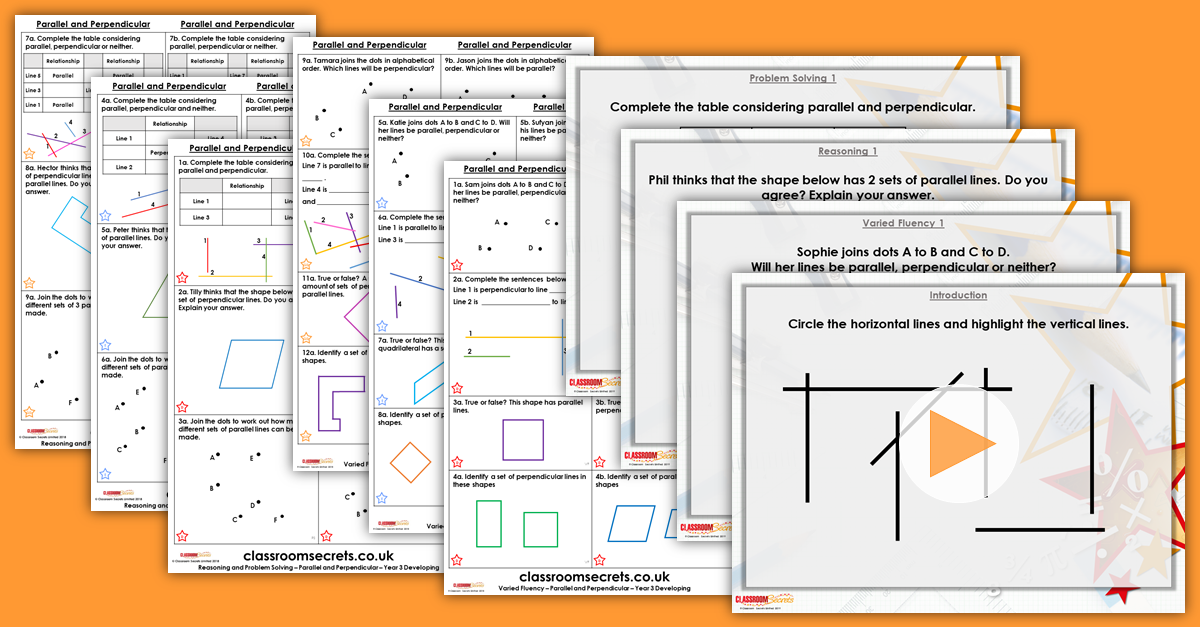Parallel and Perpendicular Year 3 Properties of Shape Resource Pack
Step 6: Parallel and Perpendicular Year 3 Summer Block 3 Resources
Parallel and Perpendicular Year 3 Resource Pack includes a teaching PowerPoint and differentiated varied fluency and reasoning and problem solving resources for Summer Block 3.
Not a member? Sign up here.
What's included in the pack?
This pack includes:
- Parallel and Perpendicular Year 3 Teaching PowerPoint.
- Parallel and Perpendicular Year 3 Varied Fluency with answers.
- Parallel and Perpendicular Year 3 Reasoning and Problem Solving with answers.
National Curriculum Objectives
Mathematics Year 3: (3G2) Identify horizontal and vertical lines and pairs of perpendicular and parallel lines
Differentiation:
Varied Fluency
Developing Questions to support identifying a set of parallel and perpendicular lines, both discretely and within shapes. Lines are horizontal and vertical only. Regular quadrilaterals used and presented in standard orientation.
Expected Questions to support identifying a set of parallel and perpendicular lines, both discretely and within shapes. Lines may be horizontal, vertical or diagonal. Regular shapes and irregular quadrilaterals may be used and may be presented in different orientations.
Greater Depth Questions to support identifying a set of more than 2 parallel and perpendicular lines, both discretely and within shapes. Most lines are diagonal but may be horizontal or vertical. Irregular and compound shapes used.
Reasoning and Problem Solving
Questions 1, 4 and 7 (Problem Solving)
Developing Complete a table showing the relationship between a set of vertical and horizontal lines, considering parallel and perpendicular.
Expected Complete a table showing the relationship between a set of vertical, horizontal or diagonal lines, considering parallel and perpendicular.
Greater Depth Complete a table showing the relationship between a set of more than 2 vertical, horizontal or diagonal lines, considering parallel and perpendicular.
Questions 2, 5 and 8 (Reasoning)
Developing Explain whether a statement is correct using knowledge of parallel and perpendicular. Shapes used include a rhombus and a rectangle in ‘standard’ orientation.
Expected Explain whether a statement is correct using knowledge of parallel and perpendicular. Regular shapes and irregular quadrilaterals used and may not be in ‘standard’ orientation.
Greater Depth Explain whether a statement is correct using knowledge of parallel and perpendicular. Irregular and compound shapes used and may not be in ‘standard’ orientation.
Questions 3, 6 and 9 (Problem Solving)
Developing Identify both sets of parallel or perpendicular lines that can be made by joining dots. Horizontal or vertical lines only.
Expected Identify all of the sets of parallel or perpendicular lines that can be made by joining dots. Most parallel or perpendicular lines are horizontal or vertical.
Greater Depth Identify all of the sets of 3 parallel or perpendicular lines that can be made by joining dots. Most parallel or perpendicular lines are diagonal.
This resource is available to download with a Premium subscription.







